Spain Plus Two Cities in 2022, Zaragoza
Parts
Sunday, October 2
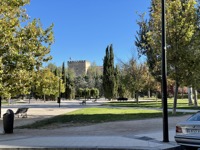 |
| Palacio de la Aljafería. |
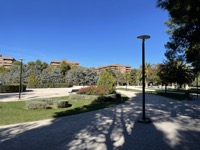 |
| Park near Palacio de la Aljafería. |
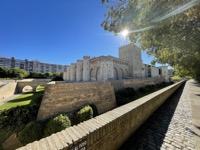 |
| Palacio de la Aljafería. |
I picked Zaragoza so that not all of my stops on this trip would be famous
cities, but it is still large (population 675,301) and is the capital of its
province. The hotel room was quite a decent size, unusual for Europe. The hotel
was around 700 meters from the train station, the farthest on this trip.
I got to Zaragoza in the afternoon and was able to get to the Palacio de la
Aljafería, a reasonable walk from my hotel, but it was fully booked for the
day. So I booked a slot for the next day and headed into the center of the
city.
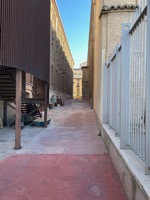 |
| Street view. |
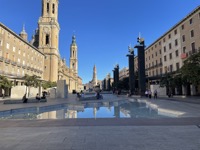 |
| Plaza del Pilar. |
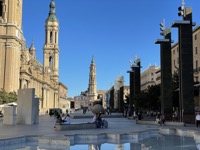 |
| Plaza del Pilar. |
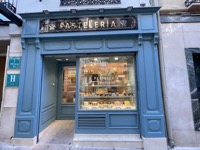 |
| Pastelería. |
 |
| Pastelería. |
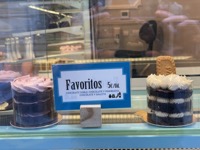 |
| Pastelería. |
 |
| Confitería Fantoba. |
While exploring, I passed by the Museo del Teatro de Caesaraugusta, a museum of
the ruins of a first-century theater. They only rediscovered it in 1972, even
though it is in the middle of town and was not buried deeply. I only saw it
from the outside this day; there is another photograph from inside on Tuesday,
October 4.
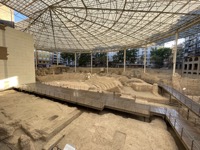 |
| Museo del Teatro de Caesaraugusta. |
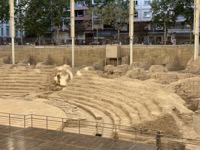 |
| Museo del Teatro de Caesaraugusta. |
 |
| Crosswalk. |
I took the photo to the right to show you crosswalks in Spain. They often are
offset from the street intersection. I do not know why. Safety? Cars will
come through the intersection and stop at the crosswalk, depending on
pedestrians and lights, with the car sometimes still partly in the
intersection.
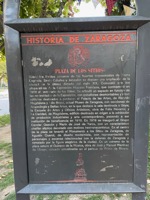 |
| Sign about Zaragoza history. |
 |
| Translated sign. |
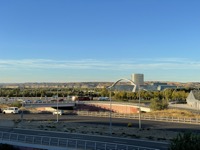 |
| View from Zaragoza. |
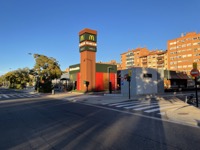 |
| Zaragoza McDonald’s. |
On the left is an example of the Translate app. The left photo is a sign I saw
in town. The right image is how it appeared in the Translate app.
For me, it was late for dinner time, but it was early for Spain, so I did not
see any open restaurants that interested me. I just headed back to the hotel
and had a sandwich there. The left of the two photos on the right is a view
walking from the train station to my hotel. The right one is a McDonald’s next
to the hotel.
Monday, October 3
 |
| Apple Maps. |
There was not much to do Monday. Most Zaragoza museums and restaurants are
closed on Mondays. To the right, you can see the result of checking Apple Maps
to see what is open—museum, closed; restaurant, closed; museum, closed; art
museum, closed. Chocolat Factory open; Apple store, open. As tempting as the
Chocolat Factory and the Apple store were, I put them off for another day, and
my tour of the Palacio de la Aljafería was not until the afternoon, so I set
off to explore things they do not close, like bridges.
Zaragoza has several bridges across its river in different styles. One is Millennium
Bridge, shown in two photos below. Since I am discussing bridges, the third
photo is a pedestrian bridge, photographed later that day, and the fourth is Bridge Pavilion,
photographed on a later day. The Bridge Pavilion spans the river and contains
exposition spaces. It was built for Expo 2008 but was closed
when I was there, and I do not know how often it is used now. Oh, apparently
they do close bridges.
Just north of Millennium Bridge is a “water park,” Parque
del Agua “Luis Buñuel,” also built for Expo 2008. I think it is supposed
to have some streams with architected courses, but it was mostly dry this day.
I am not sure whether it is tended to in summer or it has fallen into disuse.
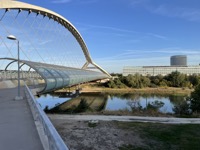 |
| Puente Tercer Milenio (Millennium Bridge). |
 |
| Puente Tercer Milenio (Millennium Bridge). |
 |
| Pedestrian bridge. |
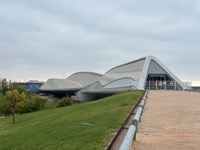 |
| Bridge Pavilion. |
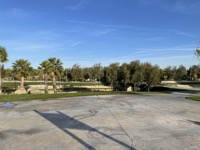 |
| Parque del Agua “Luis Buñuel.” |
Walking along the river and its bridges got me to the center of town, where I
could get back to important work, visiting chocolate stores. Not shown:
Pastelerías Manuel Segura (gritty, tasteless, unpleasant, yuck) and Bombonería
Soconusco (looked uninteresting, chose not to sample due to calorie limits).
Shown first below: Pastelerias Tolosana (okay, mild flavors, not much
interesting). Next is Jeff de Bruges, a large chain. Their web site shows 518
stores, mostly in France. Jeff de Bruges has attractive presentations, and
their chocolates are okay, but I was not generally pleased with them. Some
selected pieces might be okay.
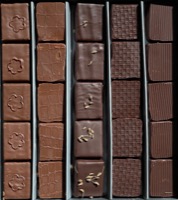 |
| Pastelerias Tolosana. |
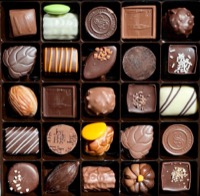 |
| Jeff de Bruges. |
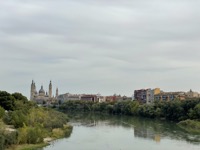 |
| Zaragoza center. |
 |
| Zaragoza center. |
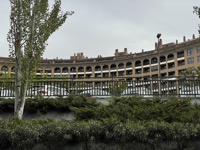 |
| Building with lots of chimneys. |
After a quick pit stop at the hotel to drop off chocolate purchases, I headed
back into the city, found lunch, and then walked to the Palacio de la Aljafería
for the tour. Near the Palacio, I noticed this building with a lot of chimneys.
It looked residential.
Wikipedia can tell you more about Palacio de la Aljafería
than I learned or remember.
 |
| Palacio de la Aljafería. |
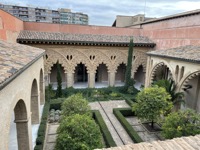 |
| Palacio de la Aljafería. |
 |
| Palacio de la Aljafería. |
Tuesday, October 4
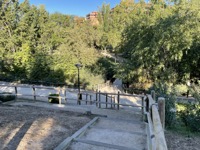 |
| Park. |
Tuesday, things were open again, and my first stop was EMOZ, the Educational Museum of
Origami in Zaragoza. First, to the right, a picture of a park I walked through
on the way to the museum.
I will let the pictures from the origami museum speak for themselves.
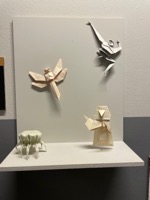 |
| Museo Origami. |
 |
| Museo Origami. |
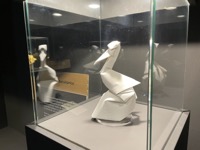 |
| Museo Origami. |
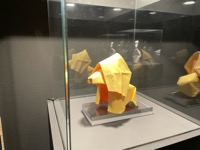 |
| Museo Origami. |
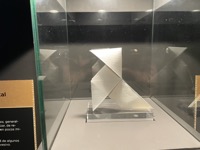 |
| Museo Origami. |
 |
| Museo Origami. |
 |
| Museo Origami. |
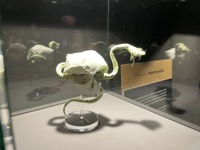 |
| Museo Origami. |
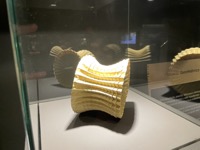 |
| Museo Origami. |
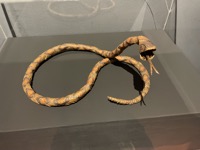 |
| Museo Origami. |
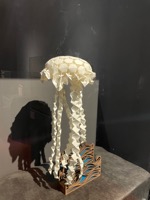 |
| Museo Origami. |
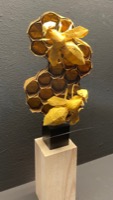 |
| Museo Origami. |
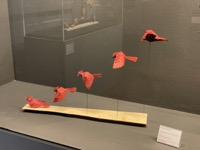 |
| Museo Origami. |
After the origami museum, I went back to the Caesaraugusta theater museum. It
is one of a several specific-site museums scattered through the old part of the
city. There were additional levels of seating in the theater. In the image
below, you can see an archway that people passed through to get in. And
although the theater is from the first century CE, there are signs it was built
in space where even earlier structures had been.
From the theater, I walked to another of the museums, the thermal baths, and
then to the forum. The forum museum is a large space under the current main
city plaza that used to be the city forum with shops and businesses. The photo
is in a tunnel to the river. One sign in the forum explained the Romans called
the city Caesaraugusta (officially Colonia Caesar Augusta), which become the
Arabic Saraqusṭa, the medieval Çaragoça, and the modern Zaragoza. And before
all that, it was Salduie or Salduba.
That light and hint of blue at the end of the tunnel is artificial; it is
modern lighting and a printed image, but the original tunnel would have led to
the river.
 |
| Sign about acoustics in the theater. |
 |
| Museo del Teatro de Caesaraugusta. |
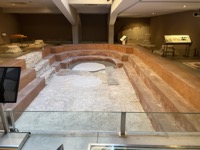 |
| Museo del Termas Públicas. |
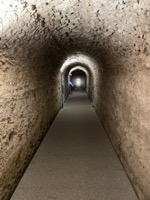 |
| Museo de Foro de Caesaraugusta. |
After these museums, I got on a crowded bus for the mall. Mask discipline on
public transit in Spain was reasonable. (Marseille was more lax, and
mask-wearers were a minority in Zürich.) Zaragoza did not seem to have any day
passes for the transit system, except for a tourist bus loop, so I figured out
how to buy tickets in their custom app and was buying one or two bus tickets
at a time.
At the mall, I found stores we do not have in the United States, like Toys “R”
Us (not pictured). Food options at the mall were better than typical in the US,
and even their condiments seem classy.
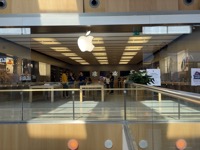 |
| Apple Store in Zaragoza. |
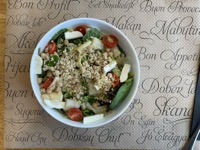 |
| Ensalata Verde con Quinoa: chickpeas, assorted green leaves, quinoa, wild asparagus, fresh cheese, and cherry tomatoes. |
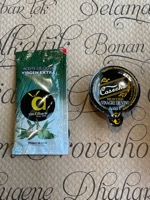 |
| Olive oil and vinegar. |
Wednesday, October 5
I started Wednesday at Museo Goya. I am not fond of Goya’s style, particularly
eyes. Then I spent some time walking around town and happened across Paturro’s
rubber duck store, shown below. That makes two so far, one in each city. They
have lots of stylized ducks—Star Trek characters, Friends characters, Lord of
the Rings, and more. But no Buffy ducks.
I still was not adapting my meal times to Spain’s patterns. I was hungry, but
it was not time for restaurants to open for lunch yet, so I defaulted to a
chain restaurant at the train station. The salad might look nice in the photo,
but it was a little lackluster. Still better than you might find in a US train
station, though. Walking back to the hotel, I noticed these markers on the
sidewalk. I had seen similar ones elsewhere but did not figure out exactly what
they were.
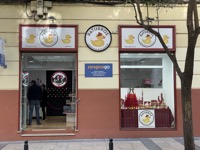 |
| Rubber duck store in Zaragoza. |
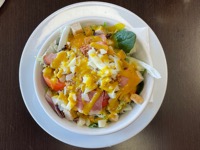 |
| Salad with crispy chicken, cheese, bacon, onion rings and sweet mustard. |
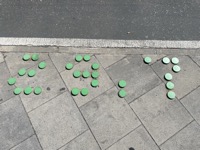 |
| Markers in sidewalk. |
Back at the hotel, I was scrolling around the Zaragoza map and found Lonely
Planet completely overlooked an amusement park near the tram. It has the Magnet
House, the Cave of Horrors, the Colorado Express, and the Mississippi.
Something to do next time I am in Zaragoza.
Thursday, October 6
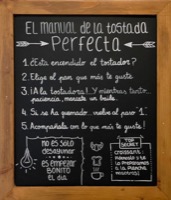 |
| Hotel Zentral breakfast sign. |
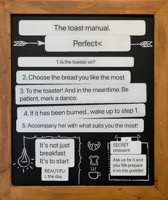 |
| Translated breakfast sign. |
Today was a travel day, with a train to Barcelona. I started with breakfast at
the hotel. I often omit breakfasts from my hotel reservations, but the hotel
images seemed to show a reasonable offering at this hotel, Zentral Ave, so I
included breakfasts, and that worked out well. There was a sign in the
breakfast room that I ignored most days, but I photographed it today to show
you how the Translate app works on handwriting.
Then it was off to the train station for waiting and reading. The train was
fine but the Renfe app did not work while on Renfe Wi-Fi. I could browse the
web generally, but I could not get updated train information in the app. When
I turned off Wi-Fi and used cellular service, the app worked.
© Copyright 2022 by
Eric Postpischil.










































